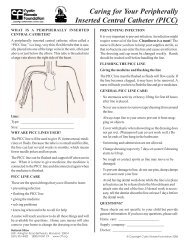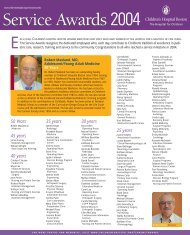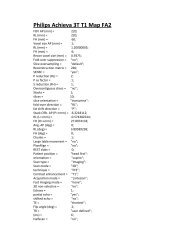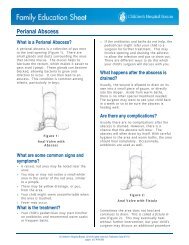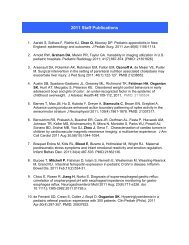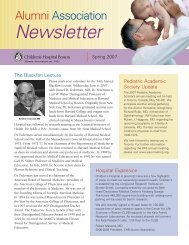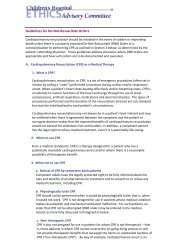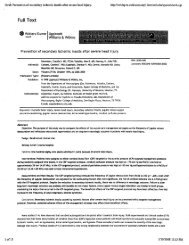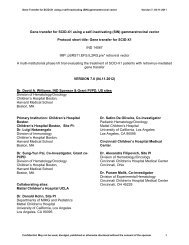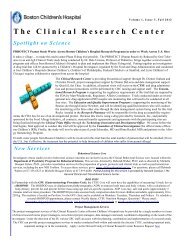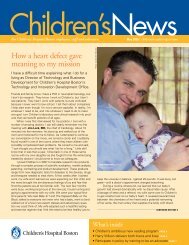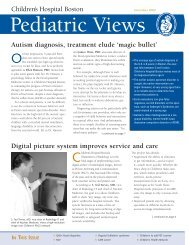Radial Club Hand - Children's Hospital Boston
Radial Club Hand - Children's Hospital Boston
Radial Club Hand - Children's Hospital Boston
Create successful ePaper yourself
Turn your PDF publications into a flip-book with our unique Google optimized e-Paper software.
Orthopedic Care Center<br />
<strong>Hand</strong> and Orthopedic Upper Extremity Program<br />
<strong>Radial</strong> <strong>Club</strong> <strong>Hand</strong><br />
Whether your child or loved one suffers a broken arm, a sports-related injury or the most complex spine condition, The Orthopedic Care Center at<br />
Children’s <strong>Hospital</strong> <strong>Boston</strong> is committed to providing comprehensive and compassionate care. Established in 1903, we are among the world’s most<br />
experienced pediatric orthopedic programs, treating a high volume of some of the most complex orthopedic conditions. And with 10 specialty clinics,<br />
we are the largest in the country. We are also one of the busiest. Each year, our staff attends to about 80,000 patient visits and conducts about 5,000<br />
surgeries. In 2010, we were ranked #1 in pediatric orthopedics by U.S. News & World Report.<br />
The <strong>Hand</strong> and Orthopedic Upper Extremity Program provides comprehensive care for infants, children and adolescents with a wide range of<br />
complex upper limb conditions. Multidisciplinary care involving occupational and physical therapy, splinting, casting and reconstructive surgeries is<br />
provided for congenital, neuromuscular, sports-related oncologic, traumatic or post-traumatic conditions.<br />
What is radial club hand?<br />
The normal hand connects with both bones of the forearm, the radius<br />
and the ulna, at the wrist. In radial club hand, a baby’s radius was not<br />
formed properly in the womb, which in turn causes the wrist to be in a<br />
fixed bent position toward the thumb side of the hand. There may be a<br />
deformity or absence of the thumb as well. The condition is sometimes<br />
called “radial dysplasia” which simply means abnormal development of<br />
the radius. In most forms of radial club hand, not only is the bone abnormal<br />
but the soft tissues and flesh of the forearm are also abnormal.<br />
The arrangement of muscles and nerves may be unbalanced and some<br />
muscles and nerves may even be absent. The most severe cases lead to<br />
significant problems in the function of the hand, fingers and elbow. The<br />
entire arm will be shorter, with marked curving of the forearm, stiffness<br />
of the elbow and fingers. In these situations, the thumb will either be<br />
very small or absent.<br />
<strong>Radial</strong> club hand is a birth defect. As with the majority of birth defects,<br />
scientists do not know why it occurs, but information that is known about<br />
radial club hand indicates that it does not result from the mother’s lifestyle<br />
or anything the mother did during her pregnancy.<br />
<strong>Radial</strong> club hand develops early in pregnancy, sometime between the<br />
28th and 56th day of gestation, when the bones of the hand and forearm<br />
are being formed. It is sometimes, but not always, picked up on a prenatal<br />
ultrasound. Even if it is detected prenatally, the condition cannot be<br />
treated until after the baby is born.<br />
The hand is comprised of many small bones called carpals, (at the<br />
base of the hand) metacarpals (in the palm area) and phalanges (in the<br />
fingers) The two bones of the forearm - the radius and the ulna - meet at<br />
the hand to form the wrist. The radius provides more of the support for<br />
the hand than does the ulna.<br />
When describing a particular side of the arm, you may hear your child’s<br />
doctor refer to the “radial side” which indicates the side of the arm on<br />
Clinical Team<br />
Peter M. Waters, MD<br />
John E. Hall Professor of Orthopedic Surgery, Harvard Medical School<br />
Clinical Chief, Orthopedic Surgery, Children’s <strong>Hospital</strong> <strong>Boston</strong><br />
Donald S. Bae, MD<br />
Assistant Professor of Orthopedic Surgery, Harvard Medical School<br />
Apurva S. Shah, MD<br />
Clinical Fellow in Orthopedic Surgery<br />
which the thumb lies, or the “ulnar side” which describes the side on which<br />
the little finger lies. These terms are used rather than “inner” or “outer”<br />
arm because the palm of the hand can face either forward or backward.<br />
As the hand rotates, the radius swings around the ulna, which is hinged<br />
to the humerus (upper arm bone) at the elbow joint.<br />
X-ray of a radial club hand.<br />
How much does radial club hand interfere with function?<br />
There are varying degrees of malformation of the radius and therefore<br />
varying degrees on how much a child’s radial club hand will affect function.<br />
In the most severe cases, the radius is completely absent, leading to<br />
very limited range of motion at the wrist. The elbow joint may also be<br />
disturbed or even fused with no motion. There may also be underdevelopment<br />
or absence of the thumb, which interferes with hand function.<br />
continued on page 2.<br />
Locations<br />
Children’s <strong>Hospital</strong> <strong>Boston</strong><br />
300 Longwood Avenue<br />
Fegan 2<br />
<strong>Boston</strong>, MA 02115<br />
Children’s <strong>Hospital</strong> <strong>Boston</strong><br />
at Waltham<br />
9 Hope Avenue<br />
Waltham, MA 02453<br />
Children’s <strong>Hospital</strong> <strong>Boston</strong><br />
at Lexington<br />
482 Bedford Street<br />
Lexington, MA 02420<br />
<strong>Boston</strong> Children’s North<br />
10 Centennial Drive<br />
Peabody, MA 01960<br />
Schedule an Appointment 617-355-6021 | childrenshospital.org/hand page 1
In the mildest cases, the radius is merely slightly smaller than the ulna<br />
and there is minimal deviation at the wrist.<br />
The severity of radial club hand is also affected by the presence of an<br />
abnormal bar of fibrous tissue that may appear in any case where the<br />
distal part (hand end) of the radius is absent. This fibrous tissue which<br />
connects the remnants of the radius to the hand, is known by the German<br />
word anlage and has a very limited ability to grow. It is attached to<br />
the radial side of the hand and wrist. As the ulna grows in the mothers’<br />
womb, the lack of growth in the radial anlage draws the hand into a deviated<br />
“club” position. This may also cause the ulna to bow.<br />
The degree to which the hand and wrist deviate at birth, depends on<br />
two factors: the degree to which the support of the radius is lacking and<br />
the degree to which the anlage tethers the wrist, allowing the ulna to<br />
push the wrist further and further into deviation as it grows.<br />
What causes radial club hand and who is affected?<br />
<strong>Radial</strong> club hand occurs sporadically with no known cause. It occurs<br />
between 1 in 30,000 and 1 in 100,000 live births. Several theories have<br />
been raised, such as maternal drug exposure, compression of the uterus,<br />
and vascular injury, but none of these have been proven. There is no<br />
known genetic link to radial club hand except when the problem is associated<br />
with other congenital anomalies or syndromes that do have a<br />
known genetic component. It has been associated with many congenital<br />
syndromes including those affecting cardiac, gastrointestinal and renal<br />
systems. It has also been linked to some chromosomal abnormalities<br />
including Trisomy 13, 18 and 21.<br />
How is radial club hand diagnosed?<br />
<strong>Radial</strong> club hand is diagnosed after inspection of the forearm and an<br />
X-ray. Your child’s doctor will want to check for other congenital deformities<br />
or syndromes that are associated with radial club hand. Further<br />
tests may depend on whether the doctor suspects any of these associated<br />
problems, including concern regarding the heart, kidneys, vertebral<br />
column, blood cells, and digestive system. In diagnosing the condition,<br />
the doctor will want to note the severity and will likely classify it as one<br />
of the following four types:<br />
Type 1: This is the mildest form of radial club hand, involving mild deviation<br />
of the wrist throughout life. Problems that can result from more severe<br />
forms, such as loss of motion, usually do not occur. Type 1 involves a<br />
defective growth plate (physis) on the distal end (hand side) of the radius.<br />
This defect leads to a minor foreshortening of the radius and a prominent<br />
distal ulna. Surgical intervention is usually not required. However, some<br />
surgery may be required to correct underdevelopment (hypoplasia) of the<br />
thumb, an associated problem that sometimes occurs in Type 1 cases.<br />
Type 2: This involves limited growth of the radius on both its distal and<br />
proximal sides. The wrist is therefore more deviated toward the radius,<br />
Clinical Team<br />
Peter M. Waters, MD<br />
John E. Hall Professor of Orthopedic Surgery, Harvard Medical School<br />
Clinical Chief, Orthopedic Surgery, Children’s <strong>Hospital</strong> <strong>Boston</strong><br />
Donald S. Bae, MD<br />
Assistant Professor of Orthopedic Surgery, Harvard Medical School<br />
Apurva S. Shah, MD<br />
Clinical Fellow in Orthopedic Surgery<br />
and the ulna bows out. Underdevelopment of the thumb is usually more<br />
significant with more deficiency in the bones of the wrist.<br />
Type 3: This involves the absence of two thirds of the radius on the hand<br />
side. The wrist is more severely deviated and the hand has limited mechanical<br />
support. The ulna is thickened and bowed. Associated problems<br />
with the thumb and fingers, such as underdevelopment or camptodactyly,<br />
a deformity in the finger joints that leads to a flexed finger or fingers.<br />
Type 4: This type of radial club hand is most common and the most severe,<br />
causing profound limitation of hand, wrist and forearm function. It<br />
involves the complete absence of the radius along with complete or near<br />
complete absence of the thumb. The ulna bowing is also most severe.<br />
The index, long and ring fingers may be involved and the elbow may have<br />
limited range of motion.<br />
How is radial club hand treated?<br />
Treatment for radial club hand can be very complex. Specific treatment<br />
will vary from child to child and will be determined by your child’s physician<br />
based on:<br />
• your child’s age, overall health, and medical history<br />
• the severity of the condition<br />
• any other deformities or syndromes associated with the problem<br />
• your child’s tolerance for specific medications, procedures, or<br />
therapies<br />
• your opinion or preference<br />
Exercises and splinting<br />
During infancy, the first goal of treatment is to achieve passive extension<br />
of the wrist and elbow into a normal position. Your child’s doctor will<br />
guide you in performing gentle but firm and frequently repeated passive<br />
stretching exercises for the wrist and elbow to help accomplish this goal.<br />
More severe cases may require casting or splinting to gradually stretch<br />
the contracted soft tissues. Still, a rigorous stretching program is an important<br />
component of any treatment plan.<br />
Once passive motion is achieved, your baby will likely need to wear<br />
a splint during the night throughout infancy and during periods of rapid<br />
growth.<br />
More severe cases, in which there is no support for the wrist without<br />
the splint, usually require surgery. However, even if your child needs<br />
surgery, keep in mind that the range of motion exercises are extremely<br />
important. Even if wrist therapy alone doesn’t resolve the wrist contracture<br />
(shortening) and deviation, this should not discourage you from<br />
continuing the exercise regimen. Any improvement in range of motion<br />
achieved through exercise will make subsequent surgery more effective<br />
and perhaps less complex.<br />
Locations<br />
Children’s <strong>Hospital</strong> <strong>Boston</strong><br />
300 Longwood Avenue<br />
Fegan 2<br />
<strong>Boston</strong>, MA 02115<br />
Children’s <strong>Hospital</strong> <strong>Boston</strong><br />
at Waltham<br />
9 Hope Avenue<br />
Waltham, MA 02453<br />
continued on page 3.<br />
Children’s <strong>Hospital</strong> <strong>Boston</strong><br />
at Lexington<br />
482 Bedford Street<br />
Lexington, MA 02420<br />
<strong>Boston</strong> Children’s North<br />
10 Centennial Drive<br />
Peabody, MA 01960<br />
Schedule an Appointment 617-355-6021 | childrenshospital.org/hand page 2
Surgical treatment<br />
Surgical treatment is usually required to correct deviation of the wrist that<br />
persists despite non-surgical means of treatment. It is also an option when<br />
the thumb limits function of the hand. However, the decision to perform<br />
surgery is weighed against any other problems that the child may be experiencing<br />
due to associated medical conditions. Also, sometimes if the<br />
child cannot flex the elbow, the presence of a bent wrist and short forearm<br />
can be an advantage, enabling a child to, for example, feed himself.<br />
Surgery is divided into phases. Each problem is treated in separate surgical<br />
procedures that may take place over the course of months or years,<br />
depending on the problem. The following is a general description of how<br />
the different parts of the arm and hand affected by radial club hand are<br />
surgically treated:<br />
The wrist<br />
Any of the following procedures may be used to offset the wrist deviation<br />
and contracture:<br />
Lengthening: This procedure is used prior to surgery to gently stretch the<br />
hand into a straighter position. A customized frame is surgically placed<br />
on the hand and forearm so that pins go through the ulna and hand. The<br />
pins in the ulna and hand are then pushed apart gradually, ( about 1mm per<br />
day). Lengthening can be recommended in infancy in situations where it is<br />
very difficult to stretch out the tight wrist. It is also used in adolescence<br />
when there is recurrent deformity or marked shortening of the forearm.<br />
Centralization: This procedure involves removing bones from the wrist<br />
so that the hand sits straight on the end of the ulna, which is sometimes<br />
placed in a slot within the wrist.<br />
<strong>Radial</strong>ization: This procedure involves moving the hand slightly further<br />
across towards the ulnar border of the forearm and reorganizing the<br />
tight muscles of the wrist so that the hand is balanced on the end of the<br />
ulna. The benefit of this procedure is that it is less likely to interfere with<br />
growth because less bone is resected and there is usually more mobility<br />
in the wrist because the muscles are restored and the ulna is not placed<br />
in a slot within the wrist.<br />
Splinting: This is usually necessary following centralization or radialization<br />
procedures. At the time of surgery, surgeons will likely create an<br />
internal splint -- a pin that is placed through the wrist and the ulna. This<br />
may remain in place for a year or even more after surgery, until the ulna<br />
gradually broadens and becomes a more stable platform on which the<br />
wrist may balance.<br />
The forearm bones<br />
Osteotomy: Often, radial club hand leads to bowing of the ulna bone. This<br />
bowing can become extreme and may even result in a twist in the forearm<br />
because of the complex arrangement of the anlage. At the time of<br />
the operation for the wrist, your child’s surgeon may want to straighten<br />
the forearm bones by cutting them into wedges, then rearranging them<br />
Clinical Team<br />
Peter M. Waters, MD<br />
John E. Hall Professor of Orthopedic Surgery, Harvard Medical School<br />
Clinical Chief, Orthopedic Surgery, Children’s <strong>Hospital</strong> <strong>Boston</strong><br />
Donald S. Bae, MD<br />
Assistant Professor of Orthopedic Surgery, Harvard Medical School<br />
Apurva S. Shah, MD<br />
Clinical Fellow in Orthopedic Surgery<br />
into a straighter position These will be held in place by the same pin<br />
that holds the wrist.<br />
Underdeveloped or absent thumb<br />
Problems with the thumb are extremely common in radial club hand, particularly<br />
in more severe cases. In many cases, surgery to reconstruct the<br />
thumb is recommended. Reconstructive surgery, either through a procedure<br />
known as pollicization or by tendon transfers, is usually performed<br />
after other procedures described above are completed. For a description<br />
of these thumb problems and surgery to correct them, see link below.<br />
Common congenital hand conditions and treatments<br />
The elbow<br />
Surgery on the elbow is very uncommon in radial club hand. However,<br />
in some cases, your child’s doctor may want to perform an operation to<br />
release the tight soft tissue structures at the back of the elbow that are<br />
causing the elbow to stiffen. This may help your child’s arm attain passive<br />
range of motion.<br />
What is the long-term outlook for a child with radial club hand?<br />
The long-term outlook is dependent on the severity of the deformity. In<br />
mild cases, intermittent therapy throughout growth is required to maintain<br />
alignment and strength. These children will have minor limitations<br />
of motion, function, and strength. In the more severe cases, there will be<br />
marked limitation of motion, strength, and function. In these situations,<br />
growth will also be limited in that forearm.<br />
Locations<br />
Children’s <strong>Hospital</strong> <strong>Boston</strong><br />
300 Longwood Avenue<br />
Fegan 2<br />
<strong>Boston</strong>, MA 02115<br />
Children’s <strong>Hospital</strong> <strong>Boston</strong><br />
at Waltham<br />
9 Hope Avenue<br />
Waltham, MA 02453<br />
Children’s <strong>Hospital</strong> <strong>Boston</strong><br />
at Lexington<br />
482 Bedford Street<br />
Lexington, MA 02420<br />
<strong>Boston</strong> Children’s North<br />
10 Centennial Drive<br />
Peabody, MA 01960<br />
Schedule an Appointment 617-355-6021 | childrenshospital.org/hand page 3





